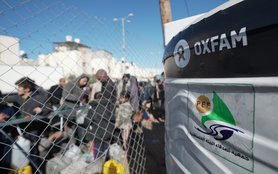The international community must pledge financial support to rebuild the lives of those affected by Cyclone Aila, which hit Bangladesh a year ago, say Oxfam.
With the threat of an impending monsoon, communities are still waiting for damaged embankments to be rebuilt so that they can return to their homes.
When Cyclone Aila swept across areas of southern Bangladesh and eastern India on May 25, 2009, it caused widespread damage and affected around three million people. In southern Bangladesh, the cyclone caused a tidal surge which broke through poorly-maintained coastal embankments. In south- western districts, especially in Satkhira and Kulna, people living in the coastal villages were forced to flee to raised embankments as houses and crops became submerged under water.
Gareth Price Jones, the Country Director of Oxfam in Bangladesh said, “It is unfortunate to see that the international community did not fulfill their pledge to provide $1.15 billion to rehabilitate cyclone Aila victims.
Today in the Shatkhira and Khulna districts, only 28 of the 452 miles of damaged embankments have been reconstructed so far. People cannot return to their homesteads, as different points of breached embankments have not yet been repaired due to inadequate resources and a lack of action. *
Over the last year Oxfam has continued to lobby the local and national government to take immediate steps to reconstruct damaged embankments to protect communities and their land from saline water.
While more than 100,000 people have fled to other parts of the country since the cyclone struck, some 125,000 people are still living in makeshift shelters on the embankments, struggling with basic needs such as shelter, clean drinking water and food. *
“One year after cyclone Aila and I am still living on the embankments. Nothing has changed in my life, things have got worse. I need pure drinking water, a house and the means to make a living,” said Shorbanu Khatun, a resident of Shatkhira.
More than three million people have been suffering due to a lack of clean drinking water since the cyclone. Only five to seven percent of the population in the area are living where tube-wells have been installed. The average distance for others to fetch drinking water is about 2.5 miles.
Oxfam has so far provided 12,000 families with 1.5 million liters of safe drinking water as well as over 9000 families with shelter. It has also provided sanitation and a means of making a living to many families.
Around 60 percent of government schools in the affected areas are still inaccessible due to water logging or due to the lack of infrastructure. Many children cannot attend school, especially girls, due to inadequate sanitation facilities.
With an impending monsoon the situation can only worsen unless the international community makes immediate arrangements to help people to cope and have access to food, shelter, safe drinking water and sanitation. Further delay will only increase the suffering of those affected.
Oxfam is also lobbying the Bangladesh government and international community for longer-term initiatives to rebuild the affected areas and help communities be better prepared for future disasters.


